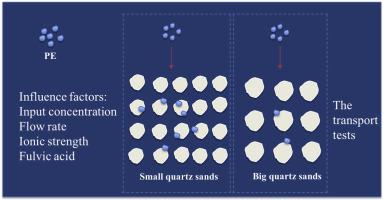当前位置:
X-MOL 学术
›
Environ. Pollut.
›
论文详情
Our official English website, www.x-mol.net, welcomes your
feedback! (Note: you will need to create a separate account there.)
Transport behavior of micro polyethylene particles in saturated quartz sand: Impacts of input concentration and physicochemical factors.
Environmental Pollution ( IF 7.6 ) Pub Date : 2020-04-02 , DOI: 10.1016/j.envpol.2020.114499 Jun Hou 1 , Xiaoya Xu 1 , Lin Lan 2 , Lingzhan Miao 1 , Yi Xu 1 , Guoxiang You 1 , Zhilin Liu 1
Environmental Pollution ( IF 7.6 ) Pub Date : 2020-04-02 , DOI: 10.1016/j.envpol.2020.114499 Jun Hou 1 , Xiaoya Xu 1 , Lin Lan 2 , Lingzhan Miao 1 , Yi Xu 1 , Guoxiang You 1 , Zhilin Liu 1
Affiliation

|
The long-term contamination of soil by microplastics may pose risks that are often still not well understood, and the ecological effects of microplastics are mainly dependent on their environmental behavior in environments. This study used saturated quartz sand as a solid porous medium to study the migration and influencing factors of 40-48 μm polyethylene (PE) particles in saturated porous media. The breakthrough curves at different injection concentrations (0.3, 0.4, 0.5 mg/L), flow rates (1.0, 1.5, 2.0, 2.5 ml/L), porous medium particle sizes (1-2, 2-4 mm), ionic strengths (0, 0.01, 0.05 mol/L) and concentrations of fulvic acid (FA) (0, 5, 10 mg/L) were compared and analyzed. The Derjaguin-Landau-Verwey-Overbeek (DLVO) theory was used to more accurately explain relevant transport behaviors. The results showed that the input concentration, flow rate, and particle size can affect the migration of PE particles individually or in combination. As ionic strength increased, the repulsion between microplastics and quartz sand gradually disappeared according to DLVO theory, and their attraction gradually strengthened. As a result, fewer microplastics could penetrate the sand column and reach the water body. With the continuous addition of FA, the repulsive energy between microplastics and quartz sand rose from DLVO theory, and the migration ability of microplastics initially increased before becoming stable because of the effect of straining. In all cases, the migration ability of PE was low (C/C0 < 0.35), and most PE particles remained in the porous media during the whole experimental periods. This study provides new insights of understanding the migration of microplastics in environment.
中文翻译:

聚乙烯微粒在饱和石英砂中的传输行为:输入浓度和理化因素的影响。
微塑料对土壤的长期污染可能会带来一些风险,而这种风险通常仍未得到很好的理解,微塑料的生态效应主要取决于其在环境中的环境行为。本研究以饱和石英砂为固体多孔介质,研究了40-48μm聚乙烯(PE)颗粒在饱和多孔介质中的迁移及其影响因素。不同进样浓度(0.3、0.4、0.5 mg / L),流速(1.0、1.5、2.0、2.5 ml / L),多孔介质粒径(1-2、2-4 mm),离子强度的穿透曲线比较并分析了(0,0.01,0.05 mol / L)和富里酸(FA)的浓度(0,5,10 mg / L)。Derjaguin-Landau-Verwey-Overbeek(DLVO)理论用于更准确地解释相关的运输行为。结果表明,输入浓度 流速和粒径会单独或组合影响PE颗粒的迁移。随着离子强度的增加,根据DLVO理论,微塑料与石英砂之间的排斥力逐渐消失,它们的吸引力逐渐增强。结果,更少的微塑料可以穿透砂柱并到达水体。DLVO理论表明,随着FA的不断添加,微塑料与石英砂之间的排斥力上升,并且由于应变作用,微塑料的迁移能力在达到稳定之前开始增加。在所有情况下,PE的迁移能力均较低(C / C0 <0.35),并且在整个实验期间,大多数PE颗粒保留在多孔介质中。
更新日期:2020-04-20
中文翻译:

聚乙烯微粒在饱和石英砂中的传输行为:输入浓度和理化因素的影响。
微塑料对土壤的长期污染可能会带来一些风险,而这种风险通常仍未得到很好的理解,微塑料的生态效应主要取决于其在环境中的环境行为。本研究以饱和石英砂为固体多孔介质,研究了40-48μm聚乙烯(PE)颗粒在饱和多孔介质中的迁移及其影响因素。不同进样浓度(0.3、0.4、0.5 mg / L),流速(1.0、1.5、2.0、2.5 ml / L),多孔介质粒径(1-2、2-4 mm),离子强度的穿透曲线比较并分析了(0,0.01,0.05 mol / L)和富里酸(FA)的浓度(0,5,10 mg / L)。Derjaguin-Landau-Verwey-Overbeek(DLVO)理论用于更准确地解释相关的运输行为。结果表明,输入浓度 流速和粒径会单独或组合影响PE颗粒的迁移。随着离子强度的增加,根据DLVO理论,微塑料与石英砂之间的排斥力逐渐消失,它们的吸引力逐渐增强。结果,更少的微塑料可以穿透砂柱并到达水体。DLVO理论表明,随着FA的不断添加,微塑料与石英砂之间的排斥力上升,并且由于应变作用,微塑料的迁移能力在达到稳定之前开始增加。在所有情况下,PE的迁移能力均较低(C / C0 <0.35),并且在整个实验期间,大多数PE颗粒保留在多孔介质中。











































 京公网安备 11010802027423号
京公网安备 11010802027423号